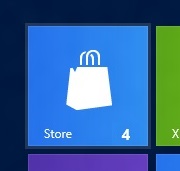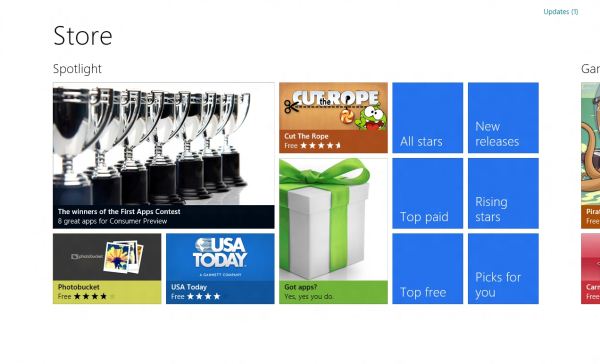In-Depth with the Windows 8 Consumer Preview
by Andrew Cunningham, Ryan Smith, Kristian Vättö & Jarred Walton on March 9, 2012 10:30 AM EST- Posted in
- Microsoft
- Operating Systems
- Windows
- Windows 8
Now that we’ve covered the bulk of Windows’ new UI elements, it’s time to get down to some individual apps, and there’s no app more important to Windows 8’s success than the Windows Store.
Unfortunately, at this point it's a bit difficult to tell how the store is going to work out—it seems like one of the less-finished apps provided in the Consumer Preview. There are basic categories for games, social apps, music apps, and a few others, but aside from the basic Search functionality (which is accessed from the Charms menu), there's just a sprawling "top free" list and a lot of scrolling. The Windows Store definitely shouldn't be judged on this early iteration, but a lack of polish (unlike in other Metro screens, more tiles don't show up when more screen space is available—if you look at the Store on a screen with a vertical resolution of much more than 768 pixels, you'll just see a big unused area of white space below the Store tiles) and missing features make it a rough demo at best.
As in both the Apple and Android app stores, you’ll need to sign in with a Windows Live ID to download anything from the Windows Store. If you used your Windows Live ID to create an account during Windows Setup, the OS can download and install apps without asking you for any extra information, but you can still use your Live ID even if you chose to create a local account. Once you’ve purchased an app, you’ll be able to download that app to any Windows 8 or Windows on ARM device you’ve signed into with your Windows Live ID.

All of the preview apps in the Windows Store are currently offered free of charge, but in the RTM version of the store developers will be able to offer both “Buy” and “Try” buttons for apps with demos—apps can have either timed or feature-limited demos available. Unlocking the full version of the app requires no separate download, and all of your saved data from the demo is still available. Info pages for apps also list compatible processor architectures—x86, x64, and ARM.

As seen above, when updates are available a small number will appear on the Windows Store tile. Entering the Store and clicking the "Updates" link in the upper right-hand corner of the screen will present a list of available updates, which you can install individually or all at once.
Apps submitted to the Windows Store have to make it through Microsoft’s approval process, which looks to be a more developer-friendly version of Apple's system: Windows 8 will be a curated platform, which should help curb some of the malware problems that Android is having. However, criteria for approval are clearly laid out, and developers whose apps are rejected will be given feedback on what changes they'll need to make to get approved. Microsoft is also updating its development tools to help guide developers through all the steps of the certification process.
For both advertisements and in-app purchases, Microsoft offers its own platforms but does not mandate their use. If a newspaper or magazine publisher has an existing database of its users and a pre-existing authentication system, that publisher is free to continue using them in its app. Apple began mandating the use of its systems for in-app purchases last year, meaning that all in-app purchases on iOS are subject to Apple’s 70/30 revenue split, and Google may be moving to prohibit third-party in-app purchases even as you read this.
Lastly, let’s assuage the fears of enterprise administrators: via group policies and PowerShell scripts, domain administrators can both permit and deny access to the Windows Store and to individual apps, and can also deploy Metro apps directly to PCs without using the Windows Store at all. This opens the door to volume-licensed apps, and will help IT admins to provide a consistent set of programs and features across different Windows 8 systems.
Whether the Windows Store will succeed remains to be seen—things like app discovery and user interface are important, but in the end the Windows Store is just a portal that will live or die on the quality and quantity of its apps. Those that are available are in a preview state, and while we’ll look at a few of the core Metro apps later on in this article, it doesn’t make a lot of sense to to do in-depth reviews of apps that are in beta-at-best states.
I will lay out one major concern up-front: while apps like Evernote and Cut the Rope do well on smartphones and tablets, I wonder how well more full-featured programs like Photoshop and Office will scale to Metro with their functionality intact. The Windows Store and its WinRT APIs are Microsoft’s future, but take this as a case in point: Microsoft is going to be shipping a copy of Office with every Windows on ARM tablet, but rather than providing Metro versions of Word, Office, PowerPoint, and OneNote to show developers how it’s done, it’s providing copies of those programs that will run only in the desktop environment, and it’s doing this in spite of the fact that no other developers will be able to use the Windows desktop on Windows-powered ARM tablets.
That doesn’t necessarily mean that Office apps will never get Metro styling, and it doesn’t mean that developers aren’t going to make some nice, feature-rich Metro apps, but Microsoft’s refusal to eat its own dog food in this case makes me a little nervous about the kind of programs we’ll end up seeing in Metro.











286 Comments
View All Comments
imaheadcase - Friday, March 9, 2012 - link
Its windows ME upgrade to win 7. Nothing but GUI changes that will effect anyone.Looks like win 8 is just a way to merge the OS to all devices besides Desktop. Seems more a dev helper OS than a consumer helper OS.
B3an - Monday, March 12, 2012 - link
*face palm*You didn't even read the article did you.
Just counting the desktop changes alone, Win 8 has far more changes than 7 did from Vista.
DrApop - Friday, March 9, 2012 - link
Well, I better go buy me a copy of windows 7 before the stop selling it. The last thing I want to do is slap this ugly windows 8 UI system on my computer!Everyone seems to be acting like this is such an innovation from microsoft, putting the same OS on phone, tablet, and now desk top. Does anyone remember Windows CE on a PDA?
Anyway, some of you love the UI, while I and others do not. We shall see how it goes when it goes on the desktop. All I know is that Microsoft had better start training up a huge slew of CS personnel because they are going have a whole bunch of people calling their CS support line when the win 8 users are unable to find anything on their computer. It is going to be a really mess for about 6-12 months. But I'm sure MS will charge for CS so that will be another revenue stream for them.
TEAMSWITCHER - Friday, March 9, 2012 - link
Given the immense negative feedback there is simply no way Microsoft can afford to launch Windows 8. They have made a massive tactical error - by tying the Metro interface to the classic Windows desktop they have assured it's failure. Desktop users don't want it - and with all the negative feedback - tablet shoppers won't either. Why should they?I really expected more from Microsoft. They have done so many good things in Windows 7. How could they possibly want to mess with that success? Is the iPad so threatening? I don't understand how they could let this happen.
londiste - Friday, March 9, 2012 - link
> Windows 8 adds new class drivers for things like USB 3.0 controllers, printers, motion sensors,wait... what - motion sensors?
did you happen to try using kinect at any stage of playing around with w8?
:)
Andrew.a.cunningham - Friday, March 9, 2012 - link
I don't have one, unfortunately. :-)The motion sensors the article refers to are things like accelerometers and gyrometers - mostly hardware you'll find in tablets.
Scali - Friday, March 9, 2012 - link
"Linux advocates act as though Microsoft has taken something away in disallowing third-party OSes on WOA devices, when in fact they’re disabling nothing that hasn’t already been disabled on most competing tablets."Nice to see someone telling it like it is for a change.
mcnabney - Friday, March 9, 2012 - link
It looks like backup functionality is only supported for DVDs and local drives in Premium. If you want to backup your system across a home network it looks like you have to upgrade to Professional. I guess MS needs more cash from people who are clever enough to make sure backups aren't stored ON THE COMPUTER NEEDING THE BACKUP.Tried the preview. Hated Metro. My multimonitor setup looks retarded with Metro running. Also had some compatibility issues relating to Steam/games. I'm pretty happy with Win7 and am unlikely to spend a bunch of money upgrading my numerous computers for marginal at best gains.
Andrew.a.cunningham - Friday, March 9, 2012 - link
Yeah, that's how it is in Windows 7, which seriously limits the feature's usefulness. We're still waiting to see how the Windows 8 product editions break down, and what features are present/excluded from each version.IlllI - Friday, March 9, 2012 - link
windows 7 will be the last version they ever use. the learning curve to windows 8 is too steep and i can't keep trying to teach them, especially with their memory not being as good as it once was.